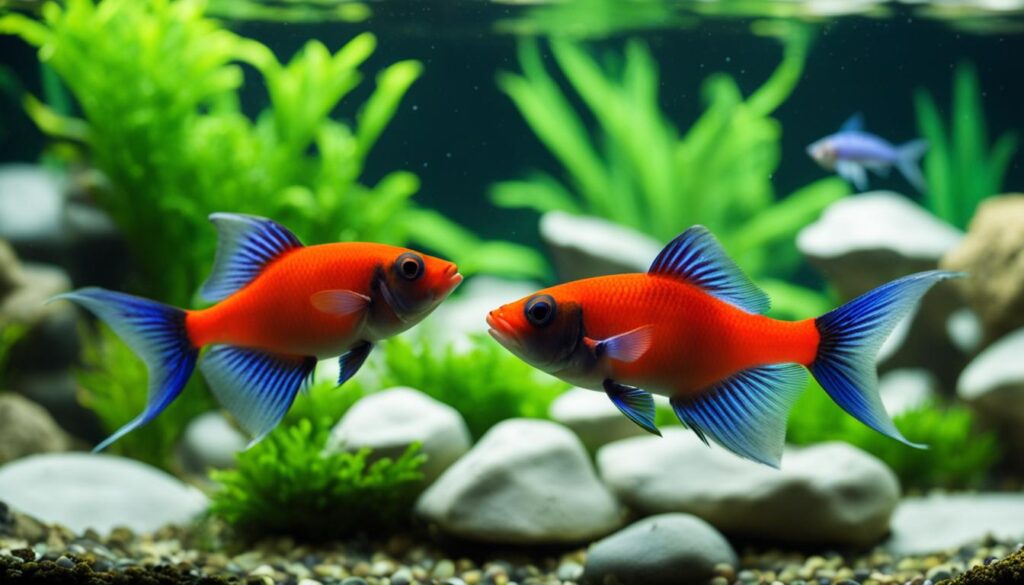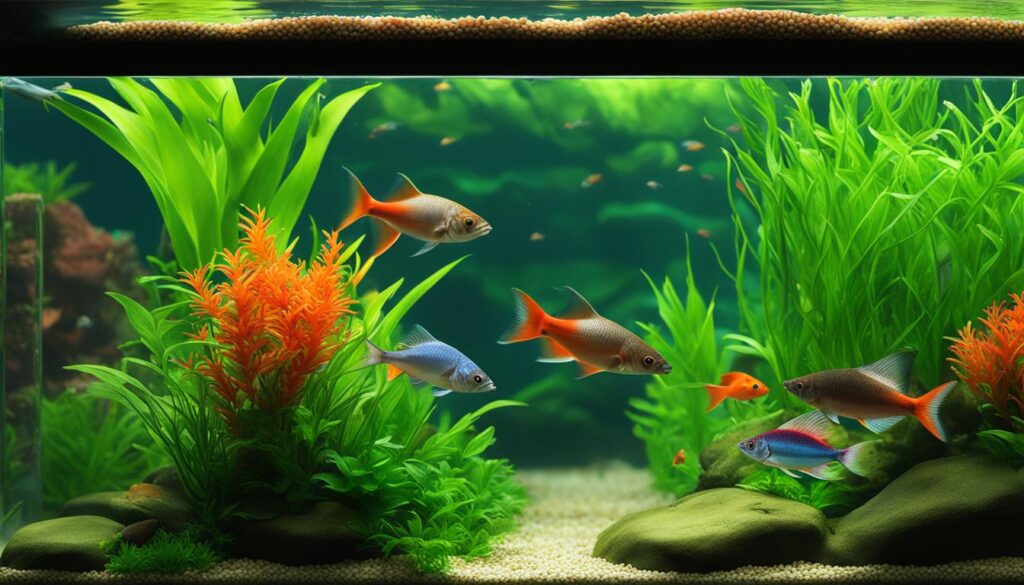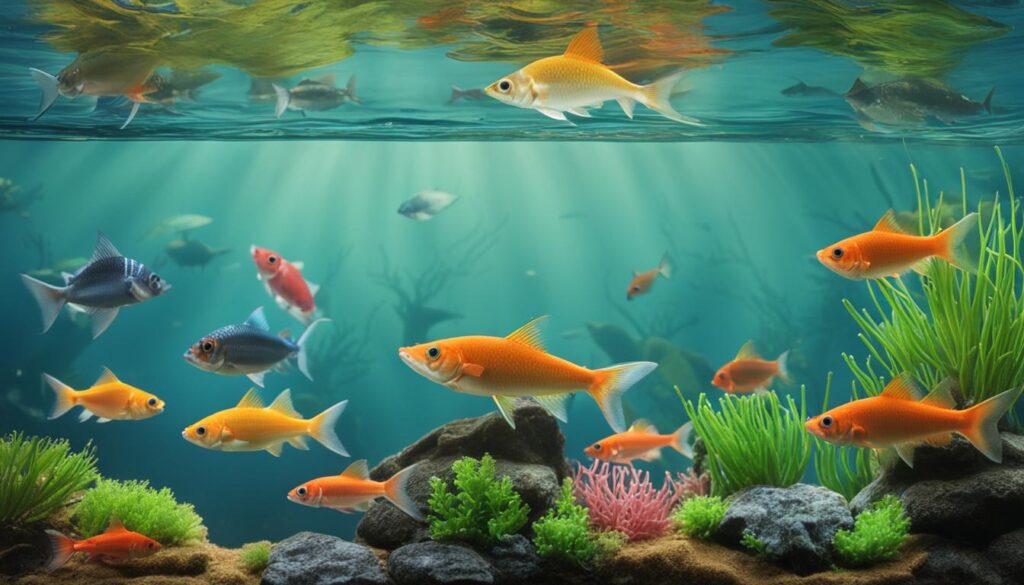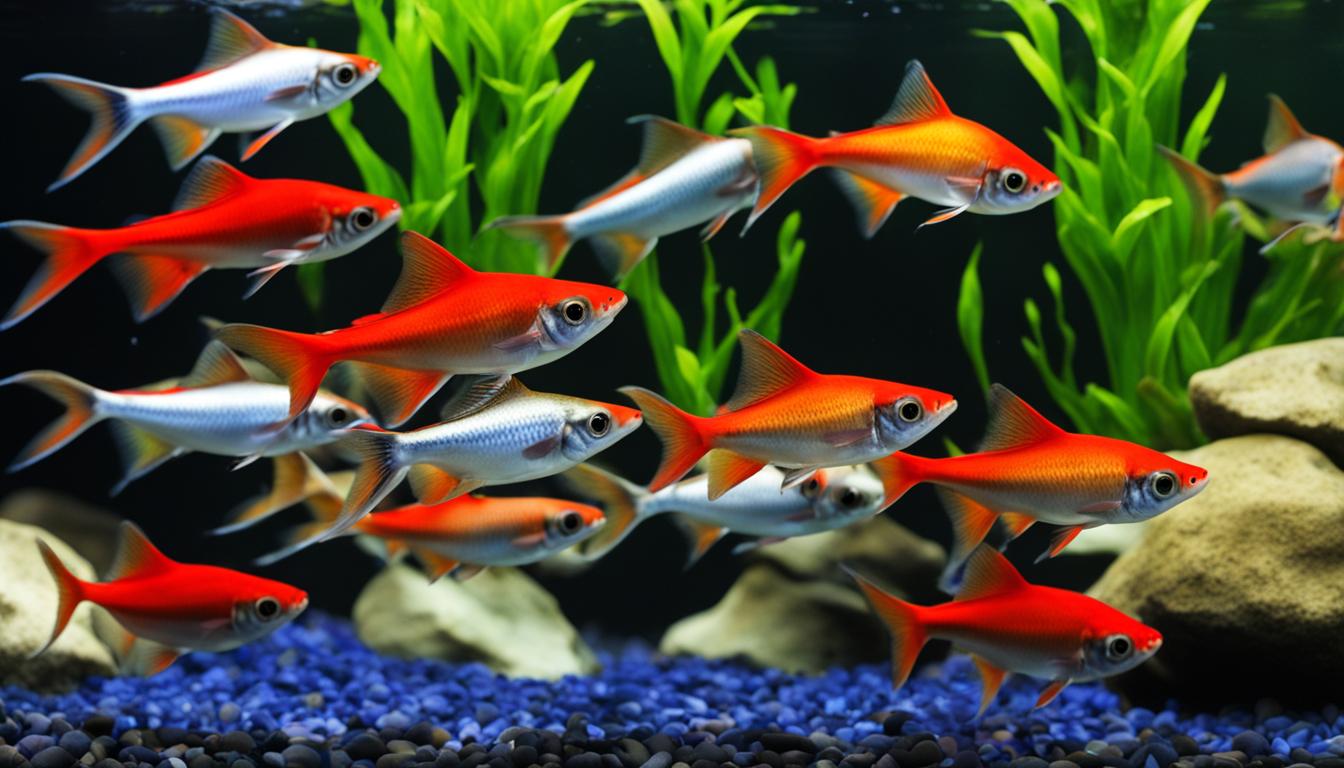Welcome to my article on the rummy nose tetra lifespan. As an aquarium enthusiast, I have always been fascinated by these vibrant and beautiful fish. In this article, we’ll explore everything you need to know about the lifespan of these popular tropical fish. From their physical characteristics and natural habitat to the care requirements needed to keep them healthy, we’ll cover it all.
Table of Contents
Key Takeaways
- The rummy nose tetra is a popular tropical fish known for its vibrant colors.
- Understanding their natural habitat is essential to providing proper care and extending their lifespan.
- The lifespan of rummy nose tetras can be influenced by various factors, including genetics, environment, and care-related aspects.
- Creating an optimal habitat and providing a balanced diet can help prolong the lifespan of rummy nose tetras.
- Recognizing signs of aging and common health issues can help keep rummy nose tetras healthy and happy.
Introducing the Rummy Nose Tetra
Welcome to the fascinating world of aquariums, where we get to explore the wonder of tropical fish. Today, we are getting to know the beautiful rummy nose tetra.
| Physical Characteristics | Natural Habitat | Behavior Patterns |
|---|---|---|
| The rummy nose tetra has a vibrant silver body with a black head and a distinctive red nose. They have a slender shape and can grow up to 2 inches in length. | The rummy nose tetra is native to the Amazon River Basin in South America. They thrive in soft, acidic water with plenty of hiding places, such as plants and driftwood. | These fish are peaceful and enjoy swimming in schools. They are active swimmers and love to explore their environment. They can be shy when first introduced to a new tank, but they quickly adapt to their surroundings. |
Now that we know some of the basic rummy nose tetra information and facts, we can move on to exploring their fascinating lifespan.
Lifespan of the Rummy Nose Tetra
The average lifespan of a rummy nose tetra is approximately 5 years in captivity. However, with proper care and attention, some individuals may live up to 7 years or more.
It is important to note that the lifespan of a fish can vary greatly depending on several factors, including genetics, environment, and care.
Factors Affecting Tetra Fish Lifespan
Genetics play a significant role in determining the lifespan of a rummy nose tetra. Some individuals may be predisposed to certain health conditions or have a weaker immune system, making them more susceptible to disease and a shorter lifespan.
The environment in which the fish are kept also has a significant impact on their lifespan. Rummy nose tetras are tropical fish that require warm water temperatures between 75-82°F (24-28°C). They also prefer soft, slightly acidic water with a pH between 6.0-7.0.
Water quality is crucial to the health of rummy nose tetras and can greatly affect their lifespan. Poor water conditions can lead to stress, disease, and premature death. It is essential to maintain a clean and well-maintained aquarium with proper filtration and regular water changes.
Proper nutrition is also vital for maintaining the health and longevity of rummy nose tetras. A balanced diet that includes a variety of high-quality foods, including live and frozen foods in addition to dry pellets or flakes, is essential.
Fish Lifespan Comparisons
In comparison to other tropical fish, the rummy nose tetra has a relatively short lifespan. Some species of fish, such as the koi fish, can live for several decades, while others, such as guppies, have a lifespan of only 1-2 years.
Overall, it is important to understand the specific care requirements of each fish species to ensure they live a healthy and fulfilling life.
Factors Influencing Rummy Nose Tetra Lifespan
Proper care is crucial in maintaining the health and longevity of rummy nose tetras. Factors such as water quality, diet, tank size, and companions can all influence their lifespan.
Water Quality
Rummy nose tetras are sensitive to changes in water parameters, making it essential to maintain a stable and clean environment. Poor water quality can cause stress, disease, and ultimately shorten their lifespan. It is recommended to perform weekly water changes and test water parameters regularly.
Water temperature should be kept between 75-82°F, with a pH range of 6.0-7.5 and water hardness of 5-12 dGH.
Diet
The diet of rummy nose tetras should be balanced and varied to promote optimal health and longevity. A diet consisting of both dry and live foods, such as bloodworms and brine shrimp, is recommended. Overfeeding can lead to health issues and a shorter lifespan, so it is important to feed them in moderation.
Tank Size
Rummy nose tetras are schooling fish and should be kept in groups of at least six individuals. A larger tank size of 20 gallons or more is recommended to provide adequate swimming space and reduce stress.
Companions
Compatible tankmates are essential for maintaining a stress-free environment for rummy nose tetras. Peaceful fish species such as other tetras, danios, and rasboras can coexist with rummy nose tetras in a community aquarium. Aggressive or territorial fish should be avoided as they can cause stress and aggression, leading to a shorter lifespan for the rummy nose tetras.
By providing the proper care and environment for rummy nose tetras, their lifespan can be extended, allowing you to enjoy their beauty and personality for years to come.
Creating an Optimal Habitat

Creating a suitable habitat is essential for the health and well-being of rummy nose tetras. These fish originate from the Amazon River basin, where the water is soft, acidic, and warm. To mimic their natural habitat, you should maintain the following tank requirements:
| Tank Size | Water Parameters | Filtration |
|---|---|---|
| At least 20 gallons | Temperature: 75-82°F; pH: 5.5-7.5; Hardness: 2-6 dKH | Aquarium filter with a slow to moderate water flow |
Decorations are also important for creating an optimal habitat. Live plants, driftwood, and rocks provide hiding places and help maintain water quality. However, be sure not to overcrowd the tank, as rummy nose tetras enjoy swimming freely.
Tip: A darker substrate, such as black sand, can also make the vibrant colors of rummy nose tetras stand out.
When it comes to tank maintenance, perform regular water changes of 20-30% every two weeks. This ensures a clean and stable environment for your fish to thrive in. Additionally, test water parameters regularly using a test kit to ensure they remain within the recommended range.
Providing a Balanced Diet
Proper nutrition is essential to ensure the health and vitality of rummy nose tetras. Their diet should be balanced, consisting of both dry and live foods. They are omnivores, and in the wild, they feed on insects, crustaceans, and small worms. In captivity, they can be fed a variety of foods, including flakes, pellets, frozen food, and live food.
When purchasing food for your rummy nose tetras, look for products that are specifically formulated for tropical fish. These foods are nutrient-rich and designed to meet the dietary needs of fish like rummy nose tetras.
It’s essential to provide a varied diet to ensure your fish receive all the necessary nutrients. Adding live foods, such as bloodworms or brine shrimp, will provide valuable protein and facilitate natural behavior patterns, such as hunting and foraging. Be careful not to overfeed your fish, as this can lead to health issues and poor water quality.
| Food Type | Frequency |
|---|---|
| Flakes or pellets | Once or twice per day |
| Frozen or live food | Once or twice per week |
Remember, a high-quality diet is a crucial component of rummy nose tetra care, and providing your fish with the proper nutrition will help them live a long and healthy life.
Tankmates for Rummy Nose Tetras

Choosing suitable tankmates for rummy nose tetras is an important aspect of their care. These friendly, peaceful fish thrive in groups, but their friendly nature can make them easy targets for aggressive tankmates.
When selecting companions for your rummy nose tetras, consider species that share similar water parameters, tank size requirements, and temperament. Some compatible tankmates include:
| Tankmate | Species Type | Water Parameters | Tank Size | Temperament |
|---|---|---|---|---|
| Otocinclus Catfish | Bottom Dweller | pH 6.8-7.5, Soft/Medium | 20 gallons or larger | Peaceful |
| Harlequin Rasbora | Mid-Level Swimmer | pH 6-7.5, Soft | 15 gallons or larger | Peaceful |
| Cherry Barbs | Middle/Top Swimmer | pH 6-8, Soft/Medium | 20 gallons or larger | Peaceful |
Remember to avoid species that may outcompete or harass rummy nose tetras, such as cichlids or larger predatory fish.
It’s essential to monitor tank dynamics regularly to ensure that all tankmates coexist harmoniously. Keep an eye out for any signs of aggression, fin nipping, or stress, and take corrective action immediately if needed.
In conclusion, selecting the right tankmates is crucial for creating a peaceful and stress-free environment for your rummy nose tetras. Take the time to research and choose compatible species that will share a harmonious existence with your colorful tetras.
Breeding and Reproduction
As I mentioned earlier, rummy nose tetras are egg-laying fish that reproduce sexually. Breeding rummy nose tetras can be an exciting and rewarding experience for aquarium hobbyists. Here are some interesting rummy nose tetra facts about their breeding habits:
- Rummy nose tetras reach sexual maturity at around 8-10 months of age.
- Males are generally smaller than females and have a more slender body shape.
- During breeding season, males will exhibit more vibrant coloration and will chase females around the tank.
- Females can lay up to 200 eggs during a single spawning event.
- After the eggs are fertilized, they will hatch within 24-36 hours.
- The fry (baby fish) are incredibly tiny and must be fed very small amounts of food initially.
If you wish to breed rummy nose tetras, you must create the right conditions for them to spawn. This includes providing a suitable breeding tank, a nutritious diet, and the right water parameters. Here’s what you’ll need to get started:
| Item | Recommendation |
|---|---|
| Breeding Tank | A separate tank of at least 10 gallons with a sponge filter and heater |
| Water Temperature | 78-82°F (26-28°C) |
| Water pH | 6.0-6.5 |
| Water Hardness | 2-6 dGH |
| Nutritious Diet | Live or frozen brine shrimp, daphnia, or vinegar eels |
Once the breeding tank is set up, you can introduce a breeding pair of rummy nose tetras. The fish will typically spawn in the early hours of the morning, and you should remove the parents once the eggs have been laid to prevent them from eating them. The eggs will hatch within a few days, and the fry can be fed infusoria or liquid fry food until they are large enough to eat more substantial foods.
“Breeding rummy nose tetras requires patience and attention to detail, but the rewards can be well worth it. Watching the tiny fry grow and develop into healthy adult fish is a truly satisfying experience.”
Recognizing Signs of Aging or Illness
As a responsible pet owner, it’s important to keep a watchful eye on the health of your rummy nose tetras. While they are relatively hardy fish, there are several common issues that you should be aware of to ensure their well-being.
- Decreased Activity: If your rummy nose tetras are less active than usual, it could be a sign of an underlying health issue.
- Changes in Appetite: Sudden changes in appetite or refusal to eat can be an indicator of a problem.
- Respiratory Issues: Rapid breathing or gasping at the water’s surface could be a sign of poor water quality or disease.
- External Symptoms: Keep an eye out for any changes in the appearance of your rummy nose tetras, such as discoloration, lesions, or abnormal growths. These could indicate a disease or infection.
If you notice any of these symptoms, it’s important to take action immediately. Isolate the affected fish and seek advice from a veterinarian or aquarium expert. Quicker diagnosis and treatment can make all the difference in your pet’s recovery.
Extending the Lifespan of Rummy Nose Tetras
If you want your rummy nose tetras to live a long and healthy life, proper care is crucial. Here are some tips to help extend their lifespan:
- Regular water changes: To maintain optimal water quality, it’s important to perform partial water changes once a week. This will help reduce the accumulation of ammonia, nitrites, and nitrates.
- Avoid overfeeding: Overfeeding can lead to obesity and digestive problems in rummy nose tetras. Feed them small amounts of food twice a day, and don’t forget to include a variety of live and dry foods in their diet.
- Provide a stress-free environment: Rummy nose tetras can be sensitive to changes in their environment, so it’s important to keep their tank stable and avoid sudden fluctuations in temperature or water chemistry.
- Keep tankmates compatible: Choose tankmates that have similar temperaments and can peacefully coexist with rummy nose tetras. Avoid aggressive or territorial fish.
By following these simple guidelines, you can help ensure your rummy nose tetras live a long and healthy life. Remember, fish lifespan can vary depending on various factors, so proper care is essential.
Providing your rummy nose tetras with a suitable environment and balanced diet is key to maximizing their longevity. Remember to monitor their behavior for any signs of aging or illness, and take appropriate measures to address any issues that arise.
Fun Facts and Interesting Trivia

Did you know that the rummy nose tetra is also known as the “red nose tetra”? This is due to the striking red coloration on their face and lower body. Here are some other fascinating facts and trivia about these beautiful fish:
- Rummy nose tetras are native to the Amazon Basin, specifically the Rio Negro and Orinoco River systems in South America.
- They are considered a schooling fish and prefer to live in groups of six or more.
- Males can be identified by their larger dorsal fin and overall slimmer body compared to females.
- Rummy nose tetras are relatively small, growing up to only two inches in length.
If you’re looking for a unique addition to your aquarium, consider adding rummy nose tetras. Their striking appearance, school behavior, and fascinating behaviors make them a popular choice among fish enthusiasts.
Conclusion
In conclusion, caring for rummy nose tetras is a rewarding experience that requires attention to detail and commitment. By providing a suitable environment and meeting their specific needs, you can ensure these beautiful fish live a long and healthy life in your aquarium. Remember to maintain proper water quality, provide a balanced diet, and pay attention to their behavior to detect any signs of illness or stress.
As with any living creature, the lifespan of rummy nose tetras can be influenced by various factors, both genetic and environmental. However, with proper care and attention, you can help extend their lifespan and enjoy their company for many years to come.
Taking it Further
If you’re interested in learning more about rummy nose tetras and aquarium keeping, consider joining a local fish club or online community. These resources can provide valuable insight and support as you continue to explore the fascinating world of fishkeeping. As always, remember to have fun and enjoy the journey!
FAQ
What is the average lifespan of a rummy nose tetra?
The average lifespan of a rummy nose tetra is around 3 to 5 years, but with proper care, they can live even longer.
What factors can influence the lifespan of rummy nose tetras?
Several factors can influence the lifespan of rummy nose tetras, including water quality, tank size, diet, and companionship with compatible fish species.
What are the tank requirements for rummy nose tetras?
Rummy nose tetras require a well-maintained tank with appropriate water parameters, including a temperature of 75-82°F (24-28°C) and a pH level of 6.0-7.5. They also prefer a tank with plenty of swimming space and hiding spots.
What should I feed my rummy nose tetras to ensure their health?
Rummy nose tetras are omnivores and enjoy a varied diet. Offer them a mix of high-quality dry foods, such as flakes or pellets, as well as live or frozen foods like bloodworms or brine shrimp to provide essential nutrients.
Can rummy nose tetras live with other fish species?
Yes, rummy nose tetras can coexist peacefully with other compatible fish species. Some suitable tankmates include peaceful community fish like neon tetras, guppies, or corydoras catfish.
How can I recognize signs of aging or illness in my rummy nose tetras?
Look out for symptoms like decreased activity levels, loss of appetite, abnormal swimming patterns, or physical abnormalities. If you notice any of these signs, it’s important to take action and seek appropriate treatment.
How can I extend the lifespan of my rummy nose tetras?
To extend the lifespan of your rummy nose tetras, maintain excellent water quality, provide a balanced and varied diet, and ensure a stress-free environment. Regular tank maintenance, including water changes and monitoring, is also crucial.
What are some fun facts about rummy nose tetras?
Rummy nose tetras are named after their distinct bright red noses, which resemble a rum-infused cocktail. They are schooling fish and prefer to be in groups of at least six for optimal social behavior.
I am a passionate aquarist with over 30 years of hands-on experience in fishkeeping. My journey began at a young age, collecting fish from the wild and learning through experimentation. Specializing in tropical fish, I bring a deep understanding of the hobby to FishKeepingMadeSimple. The site provides honest, detailed reviews of essential products and accessories to help fellow enthusiasts create the best environments for their fish.










[…] to the fascinating world of glass fish! In this section, I will provide you with essential facts and an overview of these unique freshwater fish. Glass fish, scientifically known as Parambassis […]